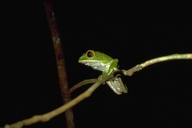|
Description
Males 82-90 mm; females 110 mm. The dorsum is uniform green and granular in texture. First and second fingers are brownish with white tips; other fingers are green with grayish brown tips. The ventral surface is white on the throat and chest, and orange-brown on the abdomen. The iris is orange-red with bold black reticulations. Distribution and Habitat
Country distribution from AmphibiaWeb's database: Colombia, Ecuador, Peru, Venezuela
Occurs throughout the Reserva Florestal Adolpho Ducke in Brazil, and breeds in ponds isolated from streams.Life History, Abundance, Activity, and Special Behaviors
The species is arboreal and nocturnal. Males call from tall shrubs near ponds. Reproduction occurs throughout the year in permanent or semi-permanent ponds, with a peak in the rainiest months (February to April). Females deposit 200 - 500 unpigmented eggs in a gelatinous mass in leaf nests hanging over ponds. The leaves are joined or folded with the aid of the male. The eggs hatch in eight to ten days, and the tadpoles fall into the pond, where they complete development until metamorphosis. Comments
Similar species: Phyllomedusa bicolor differs by having a dark gray iris, transparent brown fingers with large green adhesive discs. Phyllomedusa vaillanti differs by having a silvery-gray iris, purple flanks, and dark purple or orange adhesive discs on fingers.
Originally submitted by: Albertina P. Lima, William E. Magnusson, Marcelo Menin, Luciana K. Erdtmann, Domingos J. Rodrigues, Claudia Keller, Walter Hödl (first posted 2007-11-27)
Edited by: Kellie Whittaker (2007-11-28)Species Account Citation: AmphibiaWeb 2007 Phyllomedusa tarsius <https://amphibiaweb.org/species/662> University of California, Berkeley, CA, USA. Accessed Jan 1, 2025.
Feedback or comments about this page.
Citation: AmphibiaWeb. 2025. <https://amphibiaweb.org> University of California, Berkeley, CA, USA. Accessed 1 Jan 2025.
AmphibiaWeb's policy on data use.
|
